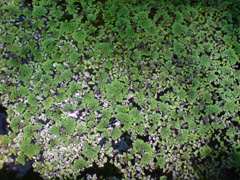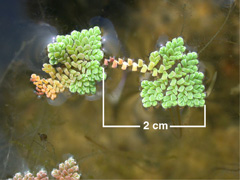 |
|
wikimedia.org User:Laxskinn |
 |
| wikimedia.org User:Tpa2067 |
Translate this page:
Summary
Red Azolla is a small, floating fern - one of only six, free-floating, aquatic fern species. It grows from 1 cm to 2.5 cm wide and is a bright green colour. Its colour changes to deep red when it is exposed to the sun. Azolla grows in waterways in dense patches, which can look like a green or red carpet. From a distance it may be confused with Salvinia, a noxious aquatic weed, or the scum of a blue-green algal bloom. It has a symbiotic relationship with the nitrogen-fixing cynobacterium Anabaena azollae. As such, it is used as a green manure particularly by rice farmers.
Physical Characteristics
![]()
![]() Azolla pinnata is an evergreen Fern at a fast rate.
Azolla pinnata is an evergreen Fern at a fast rate.
See above for USDA hardiness. It is hardy to UK zone 10. The plant is not self-fertile.
It can fix Nitrogen.
It is noted for attracting wildlife.
Suitable for: light (sandy), medium (loamy) and heavy (clay) soils. Suitable pH: mildly acid, neutral and basic (mildly alkaline) soils and can grow in very acid and very alkaline soils.
It can grow in full shade (deep woodland) semi-shade (light woodland) or no shade. It prefers moist or wet soil and can grow in water.
UK Hardiness Map
US Hardiness Map
Synonyms
No synonyms are recorded for this name.
Plant Habitats
Edible Uses
References More on Edible Uses
Medicinal Uses
Plants For A Future can not take any responsibility for any adverse effects from the use of plants. Always seek advice from a professional before using a plant medicinally.
None known
References More on Medicinal Uses
The Bookshop: Edible Plant Books
Our Latest books on Perennial Plants For Food Forests and Permaculture Gardens in paperback or digital formats.

Edible Tropical Plants
Food Forest Plants for Hotter Conditions: 250+ Plants For Tropical Food Forests & Permaculture Gardens.
More

Edible Temperate Plants
Plants for Your Food Forest: 500 Plants for Temperate Food Forests & Permaculture Gardens.
More

More Books
PFAF have eight books available in paperback and digital formats. Browse the shop for more information.
Shop Now
Other Uses
Compost Green manure
Other uses rating: High (4/5). Suitable for bogs, ponds and water gardens. Agroforestry Uses: The plant is used as a green manure in paddy fields, in particular to add nitrogen and organic matter to the soil[ 46 , 200 ]. The nitrogen-rich roots can be added to compost heaps, where they act as an activator to speed up the compost-making process[ K ]. Other Uses: It is a food source for waterfowl, fish, shrimp, insects, worms, snails and crustaceans. It provides habitat for many of the small organisms mentioned above. Mats of Azolla can actually discourage blue-green algal blooms. They restrict the penetration of sunlight into the water, which is essential for algal growth, and take up nutrients from the water column, limiting the availability of this food source for the algae. The mats of Azolla can be a form of biological mosquito control, preventing mosquito larvae surfacing for air. The presence of Azolla can also restrict the growth of exotic aquatic plants, including Salvinia and Water Hyacinth, as it limits the availability of nutrients to these plants. 1. Nectary - Flowers rich in nectar and pollen:
No – Azolla pinnata does not produce flowers; it reproduces primarily through vegetative means and produces spores.
2. Wildlife - Food (Fruit, Seeds, Leaf litter, Shelter, Nesting, Roosting):
Yes – Azolla can serve as a food source for various aquatic wildlife, including fish and invertebrates. It may not provide direct nesting or roosting sites but can contribute to the overall habitat quality in aquatic ecosystems.
3. Invertebrate Shelter (Overwintering sites, Leaf litter, Groundcover):
Yes – Azolla forms dense mats on the water’s surface, providing shelter for invertebrates and creating habitat diversity in aquatic environments.
4. Pest Confuser (Smell):
No – Azolla does not have a strong aromatic quality that would help confuse pests.
Special Uses
Attracts Wildlife Food Forest Nitrogen Fixer
References More on Other Uses
Cultivation details
Succeeds in tropical and subtropical areas. It grows best in areas where annual daytime temperatures are within the range 20 - 35°c, but can tolerate 15 - 40°c[ 418 ]. Succeeds in ponds and lakes[ 200 ]. Plants are able to tolerate a very wide range of pH from 3.5 - 10.5[ 418 ]. Plants increase so prolifically that they can become invasive[ 200 ]. The presence of Azolla in a waterway is generally
beneficial. However, in circumstances where waterways are extremely rich in nutrients, prolific growth may be a problem. It also is possible that thick, complete coverings of Azolla can cause de-oxygenation of the water. This can affect organisms such as fish and other aquatic plants, and the decay of the latter can
lead to a strong odour. However, situations like this are rare because coverage of the waterway by the Azolla needs to be almost total for it to have a negative impact on the ecosystem. Self-fertile? Azolla pinnata does not produce flowers; it reproduces primarily through vegetative means and produces spores. Azolla can be harvested throughout the growing season, typically in spring and summer when it is actively growing and flourishing.
Azolla does not flower in the traditional sense; it produces spores, which can occur year-round under suitable conditions.
References Carbon Farming Information and Carbon Sequestration Information
Temperature Converter
Type a value in the Celsius field to convert the value to Fahrenheit:
Fahrenheit:
The PFAF Bookshop
Plants For A Future have a number of books available in paperback and digital form. Book titles include Edible Plants, Edible Perennials, Edible Trees,Edible Shrubs, Woodland Gardening, and Temperate Food Forest Plants. Our new book is Food Forest Plants For Hotter Conditions (Tropical and Sub-Tropical).
Shop Now
Plant Propagation
Division.
Other Names
If available other names are mentioned here
Water Fern, Ferny or Red Azolla
Native Range
TEMPERATE ASIA: Anhui Sheng (southeast), Fujian Sheng, Henan Sheng, Hubei Sheng, Japan, Jiangsu Sheng, Jiangxi Sheng, Sichuan Sheng, Taiwan, Zhejiang Sheng,China.
TROPICAL ASIA: Bangladesh, India, Sri Lanka, Nepal, Pakistan, Papua New Guinea, Myanmar, Thailand, Vietnam, Indonesia, Philippines, PACIFIC: New Caledonia AUSTRALASIA: Australia, New South Wales, Queensland, Victoria, Northern Territory,
AFRICA: Kenya, Tanzania, Uganda, Burundi, Central African Republic, Cameroon, Democratic Republic of the Congo, Congo, Gabon, Rwanda, Côte D Ivoire, Ghana, Guinea, Liberia, Nigeria, Senegal, Sierra Leone, Angola, Mozambique, Zambia, Botswana, South Africa, KwaZulu-Natal, Madagascar.
Weed Potential
Right plant wrong place. We are currently updating this section.
Please note that a plant may be invasive in one area but may not in your area so it's worth checking.
United States:Noxious weed/invasive - Alabama, California, Massachusetts, North Carolina, Oregon, South Carolina,Vermont.
Conservation Status
IUCN Red List of Threatened Plants Status : Least Concern

Growth: S = slow M = medium F = fast. Soil: L = light (sandy) M = medium H = heavy (clay). pH: A = acid N = neutral B = basic (alkaline). Shade: F = full shade S = semi-shade N = no shade. Moisture: D = dry M = Moist We = wet Wa = water.
Now available:
Food Forest Plants for Mediterranean Conditions
350+ Perennial Plants For Mediterranean and Drier Food Forests and Permaculture Gardens.
[Paperback and eBook]
This is the third in Plants For A Future's series of plant guides for food forests tailored to
specific climate zones. Following volumes on temperate and tropical ecosystems, this book focuses
on species suited to Mediterranean conditions—regions with hot, dry summers and cool, wet winters,
often facing the added challenge of climate change.
Read More
Expert comment
Author
R.Br.
Botanical References
Links / References
For a list of references used on this page please go here
A special thanks to Ken Fern for some of the information used on this page.
Readers comment
| Add a comment |
|
If you have important information about this plant that may help other users please add a comment or link below. Only comments or links that are felt to be directly relevant to a plant will be included. If you think a comment/link or information contained on this page is inaccurate or misleading we would welcome your feedback at [email protected]. If you have questions about a plant please use the Forum on this website as we do not have the resources to answer questions ourselves.
* Please note: the comments by website users are not necessarily those held by PFAF and may give misleading or inaccurate information.
To leave a comment please Register or login here All comments need to be approved so will not appear immediately.
|
|